The 100th anniversary of the First World War is now finished but the records will continue to be preserved at the Archives and accessible to current and future generations who want to know more about the time period. In addition, this blog will remain on our website as an additional resource.
November 2014 Posts:
- 24 November: Registering for War
- 17 November: Shifting into Gear
- 10 November: Lest We Forget: Records document Manitoba casualties of the First World War
- 3 November: The Troops
24 November 2014
Registering for War
In the fall of 1914, Frank Leathers left Minto, Manitoba to begin his studies at the University of Manitoba. In a letter to his mother soon after his arrival in September he noted his first impressions of Winnipeg: “The tremendous number of street cars and the frequency with which a solider comes in sight are the things that have impressed me most.” In his letters home Frank described registering in engineering, initiation rituals, social activities and his studies, but the impact of the First World War was evident as he noted the arrival to Winnipeg of soldiers from outlying towns and speculated on when enlisted acquaintances would be sent to the front.
Like many of his peers, Frank was quick to join the university military corps, but not long after, in November 1914, he enlisted with the Canadian Field Artillery. He wrote to tell his mother the news: “I am not thinking of the reasons I should go. I do not know any why I should stay except the pain it will cause you all at home.” Frank felt that he had made the right decision but knew that he had a difficult time ahead saying, “I am not sorry for what I have done but I feel more lonely than I ever felt before.” Instead of studying and going to lectures and graduating with an Engineering degree in 1918, Frank had signed up to spend four years overseas fighting in some of the First World War’s bloodiest battles.
Throughout the war Frank wrote detailed letters home about his military experiences including training, activities and accommodations. He mentioned wartime conditions in England and his travels there while on leave, conditions in France and his interactions with French citizens. He also wrote about conditions at the front, his work in the artillery, time spent in hospital, and the end of the war. These letters were donated to the Archives of Manitoba in 1984. Visit the Archives to read them!

Search Tip: Search Frank Leathers in Keystone to find out more.
Feedback (0)
E-mail us at archiveswebmaster@gov.mb.ca with a comment about this blog post. Your comments may be included on this page.
17 November 2014
Shifting into Gear
On 9 October 1914, Hudson’s Bay Company began a new business venture when it signed its first contract with the government of France, becoming the latter’s purchasing agent during the First World War. A few weeks later, this role was put into action as the first ships and shipments were arranged and dispatched. These early efforts are documented in various records held in the Hudson’s Bay Company Archives, located here at the Archives of Manitoba. The work of procuring and shipping the supplies was complex as can be seen through examination of the records of these business activities, such as the ones shown below from November and December 1914.
This first record below, dated 12 November 1914, lays out the order for “contract #1” and it verifies the port, approximate date of departure, type and quantity of supplies being shipped and the terms to be followed.

These next two records provide details about the insurance of the cargo and ship, identified in one as the barber line Dunclutha, which was scheduled to depart New York and head to Bordeaux, France.
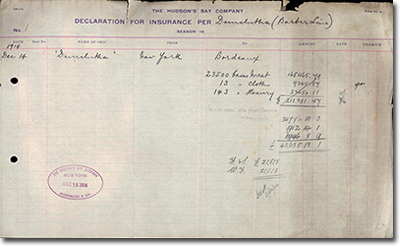
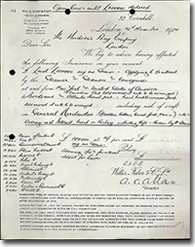
Search Tip: To find descriptions of related records, search Keystone with keywords “Purchases Department” and “Insurance Department.”
Feedback (0)
E-mail us at archiveswebmaster@gov.mb.ca with a comment about this blog post. Your comments may be included on this page.
10 November 2014
Lest We Forget: Records document Manitoba casualties of the First World War
From outset to armistice, the Manitoba government sought to keep track of the many men – each a son, husband, brother, or father – killed in action during the First World War. Hundreds of index cards containing concise biographical information relating to the lives, and untimely deaths, of soldiers killed in action were collected for the purpose of composing an honour role. These index cards are now stored at the Archives of Manitoba. Though they represent an incomplete list of all those who sacrificed their lives during the conflict, these records offer a window into the impact of war on Manitoba families and communities.
The four index cards below show the various kinds of information contained within the index card collection (Archives of Manitoba, A 0156, Index cards identifying soldiers killed in World War I, GR8115).
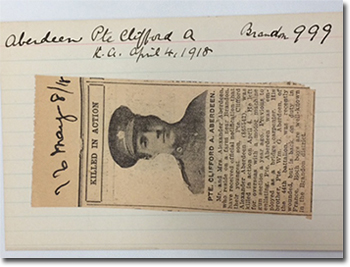
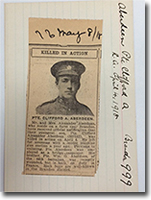
enlarge image (rotated)
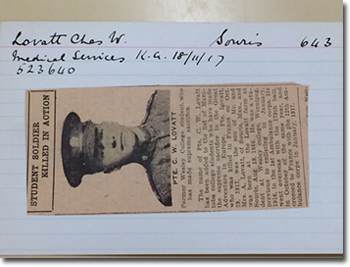
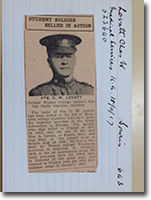
enlarge image (rotated)
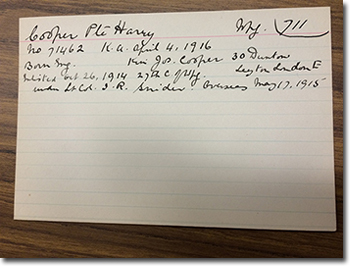
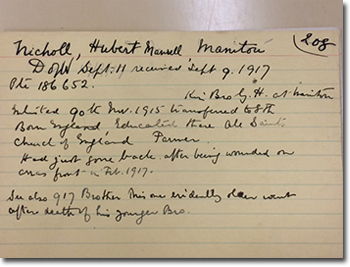
Search Tip: Search “Index cards identifying soldiers killed in World War I” Keystone to find out moreabout these records.
Feedback (0)
E-mail us at archiveswebmaster@gov.mb.ca with a comment about this blog post. Your comments may be included on this page.
3 November 2014
The Troops
Our current exhibit at the Archives, At Home: Winnipeg, 1914-1915, features reproductions of photographs taken by L.B. Foote in and around Winnipeg one hundred years ago. The images show us aspects of Winnipeg life from that time such as sports teams, beach scenes, and construction projects. The First World War would have impacted nearly all aspects of life at that time and so the exhibit also includes several images, like the one below, related to some who served in the military.
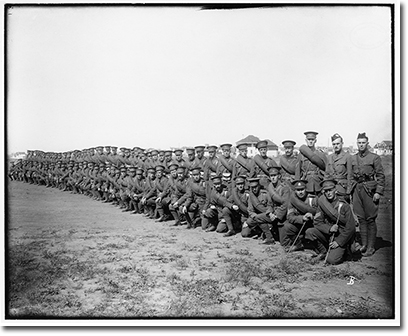
We are closed on Remembrance Day (November 11th) but we welcome you to take in the exhibit at the Archives of Manitoba during regular hours. On November 20th you can join us for a free public tour which includes a look at the exhibit.
Feedback (0)
E-mail us at archiveswebmaster@gov.mb.ca with a comment about this blog post. Your comments may be included on this page.



